Equity and Trust
VerifiedAdded on 2023/01/18
|10
|2835
|99
AI Summary
This study material explores the principles of equity and trust, including legalities, theory of equity, trusts, gaps in equity and trust, remedies of equity, formalities, and the distinction between equitable interest and legal interest. It also covers the validity of trusts, remedies for trust breach, and concludes with the importance of maintaining certainties in equity and trust laws.
Contribute Materials
Your contribution can guide someone’s learning journey. Share your
documents today.
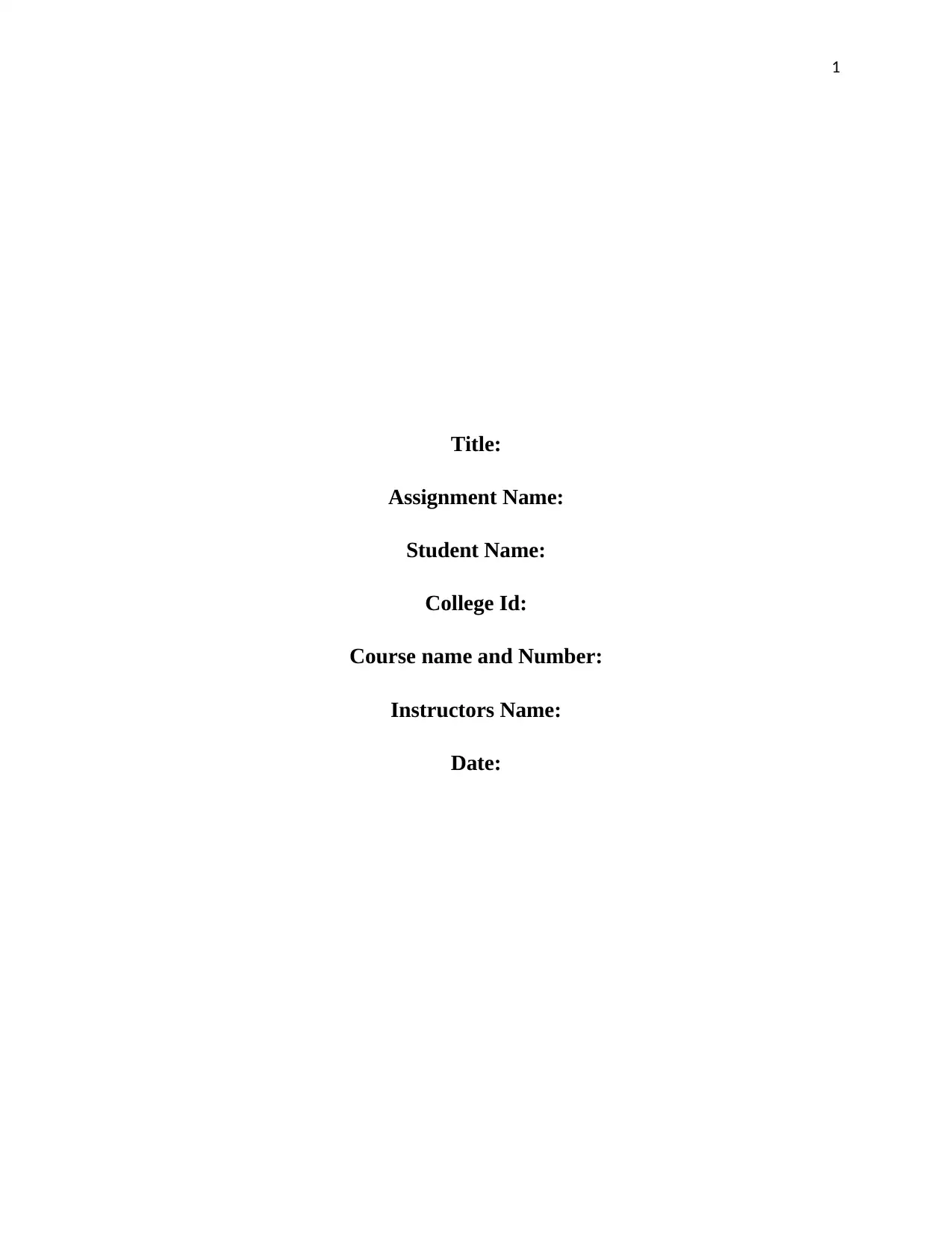
1
Title:
Assignment Name:
Student Name:
College Id:
Course name and Number:
Instructors Name:
Date:
Title:
Assignment Name:
Student Name:
College Id:
Course name and Number:
Instructors Name:
Date:
Secure Best Marks with AI Grader
Need help grading? Try our AI Grader for instant feedback on your assignments.

Equity and Trust
Table of Contents
Introduction......................................................................................................................................3
Legalities..........................................................................................................................................3
Theory of Equity..............................................................................................................................3
General addressable of Equity.........................................................................................................3
Trusts...............................................................................................................................................4
Gaps in equity and trust...................................................................................................................4
Remedies of Equity..........................................................................................................................4
Formalities.......................................................................................................................................5
Difference between Equitable interest and Legal interest...............................................................5
Valid Trust.......................................................................................................................................6
The distinction of valid trust............................................................................................................6
Remedies of Trust Breach...............................................................................................................7
Conclusion.......................................................................................................................................8
Bibliography....................................................................................................................................9
2
Table of Contents
Introduction......................................................................................................................................3
Legalities..........................................................................................................................................3
Theory of Equity..............................................................................................................................3
General addressable of Equity.........................................................................................................3
Trusts...............................................................................................................................................4
Gaps in equity and trust...................................................................................................................4
Remedies of Equity..........................................................................................................................4
Formalities.......................................................................................................................................5
Difference between Equitable interest and Legal interest...............................................................5
Valid Trust.......................................................................................................................................6
The distinction of valid trust............................................................................................................6
Remedies of Trust Breach...............................................................................................................7
Conclusion.......................................................................................................................................8
Bibliography....................................................................................................................................9
2
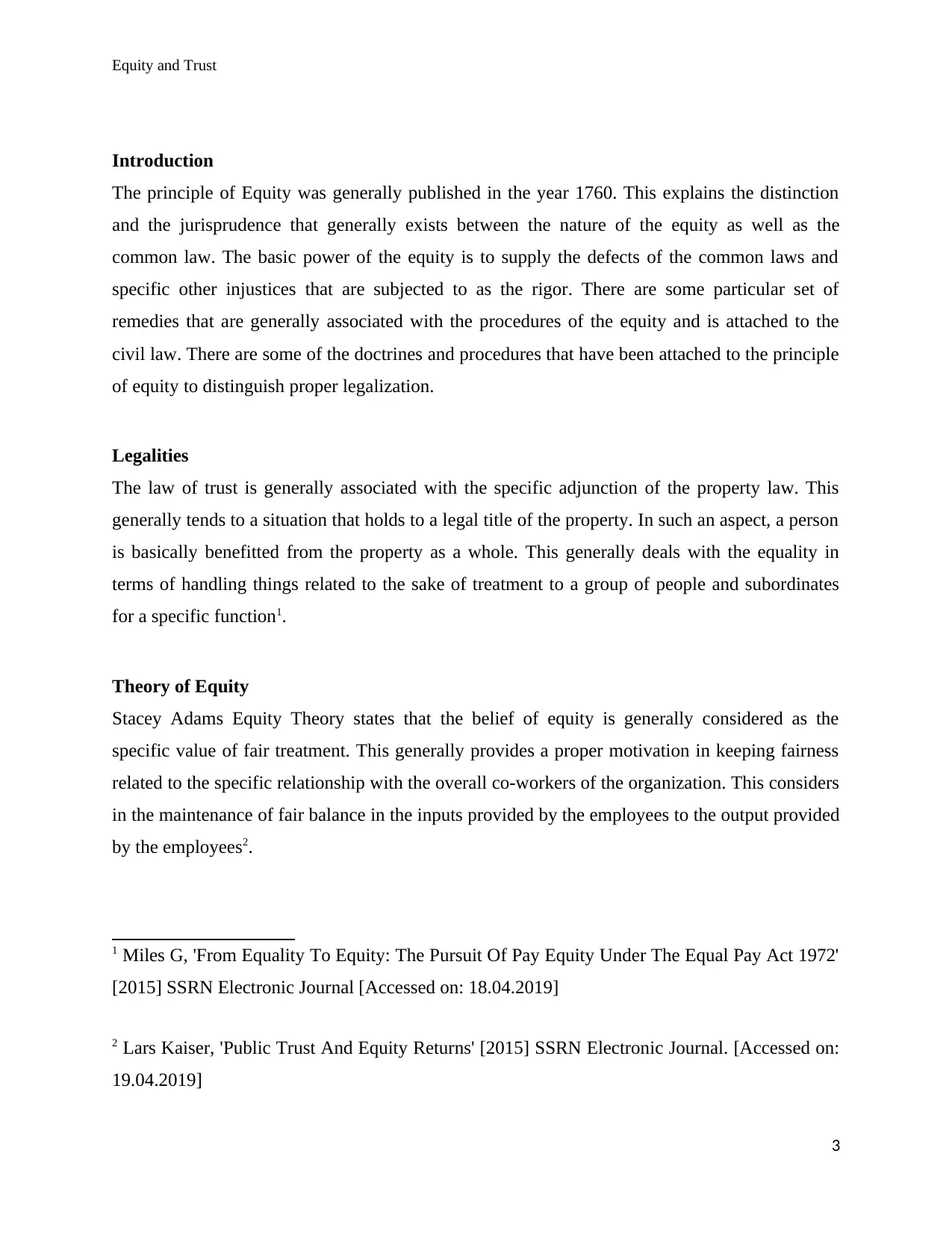
Equity and Trust
Introduction
The principle of Equity was generally published in the year 1760. This explains the distinction
and the jurisprudence that generally exists between the nature of the equity as well as the
common law. The basic power of the equity is to supply the defects of the common laws and
specific other injustices that are subjected to as the rigor. There are some particular set of
remedies that are generally associated with the procedures of the equity and is attached to the
civil law. There are some of the doctrines and procedures that have been attached to the principle
of equity to distinguish proper legalization.
Legalities
The law of trust is generally associated with the specific adjunction of the property law. This
generally tends to a situation that holds to a legal title of the property. In such an aspect, a person
is basically benefitted from the property as a whole. This generally deals with the equality in
terms of handling things related to the sake of treatment to a group of people and subordinates
for a specific function1.
Theory of Equity
Stacey Adams Equity Theory states that the belief of equity is generally considered as the
specific value of fair treatment. This generally provides a proper motivation in keeping fairness
related to the specific relationship with the overall co-workers of the organization. This considers
in the maintenance of fair balance in the inputs provided by the employees to the output provided
by the employees2.
1 Miles G, 'From Equality To Equity: The Pursuit Of Pay Equity Under The Equal Pay Act 1972'
[2015] SSRN Electronic Journal [Accessed on: 18.04.2019]
2 Lars Kaiser, 'Public Trust And Equity Returns' [2015] SSRN Electronic Journal. [Accessed on:
19.04.2019]
3
Introduction
The principle of Equity was generally published in the year 1760. This explains the distinction
and the jurisprudence that generally exists between the nature of the equity as well as the
common law. The basic power of the equity is to supply the defects of the common laws and
specific other injustices that are subjected to as the rigor. There are some particular set of
remedies that are generally associated with the procedures of the equity and is attached to the
civil law. There are some of the doctrines and procedures that have been attached to the principle
of equity to distinguish proper legalization.
Legalities
The law of trust is generally associated with the specific adjunction of the property law. This
generally tends to a situation that holds to a legal title of the property. In such an aspect, a person
is basically benefitted from the property as a whole. This generally deals with the equality in
terms of handling things related to the sake of treatment to a group of people and subordinates
for a specific function1.
Theory of Equity
Stacey Adams Equity Theory states that the belief of equity is generally considered as the
specific value of fair treatment. This generally provides a proper motivation in keeping fairness
related to the specific relationship with the overall co-workers of the organization. This considers
in the maintenance of fair balance in the inputs provided by the employees to the output provided
by the employees2.
1 Miles G, 'From Equality To Equity: The Pursuit Of Pay Equity Under The Equal Pay Act 1972'
[2015] SSRN Electronic Journal [Accessed on: 18.04.2019]
2 Lars Kaiser, 'Public Trust And Equity Returns' [2015] SSRN Electronic Journal. [Accessed on:
19.04.2019]
3

Equity and Trust
General addressable of Equity
The equity generally addresses to the people of chaos and in the orders of craving with a fair
adjustment in claims and remedies. This also acts as a defendant from the properties and the
jurisdiction. In such aspect the court explains that a person cans his or her share only when he or
she establishes a good trust and act as a good conscience3.
Trusts
The trust holds the basic relationship between the trustee and the beneficiary which are being
constituted with the preferable legal and equitable title. This generally lays upon the trustees or
the beneficiary which are in partnership. There are special dependencies based on the equitable
roots. Therefore in such aspect, it has been seen that the trust funds have become the most
important structure in specific retirement schemes, and also in Pensions and different kinds of
the Superannuation system. This is because such funds are generally considered as the trust
funds4.
Gaps in equity and trust
There are specific developments and trends that are related to the laws. The societies are being
developed and there are more complex reasons and dilemmas that lead to the evolvement of the
equity courts. Therefore such disputes are considered as the main area of the intervention related
to equity. Property disputes are considered as the main area of disputes in the overall equitable
intervention. There are recent trends that exist in the pension funds and the superannuation
creates specific problems in the contribution of programs5. This is considered obligatory in terms
3 Guillermo Suárez Blázquez, 'Triángulo histórico jurídico mágico: fideicomiso & equity &
trust/a history magic triangle: fideicomiso & equity & trust' (2017) 10 revista quaestio iuris.
[Accessed on: 19.04.2019]
4 Azadeh Shafaei, Mehran Nejati and Nina Maadad, 'Brand Equity Of Academics: Demystifying
The Process' [2019] Journal of Marketing for Higher Education. [Accessed on: 20.04.2019]
5 Andrew M. Jones, 'Equity, Opportunity And Health' [2019] Empirica. [Accessed on:
20.04.2019]
4
General addressable of Equity
The equity generally addresses to the people of chaos and in the orders of craving with a fair
adjustment in claims and remedies. This also acts as a defendant from the properties and the
jurisdiction. In such aspect the court explains that a person cans his or her share only when he or
she establishes a good trust and act as a good conscience3.
Trusts
The trust holds the basic relationship between the trustee and the beneficiary which are being
constituted with the preferable legal and equitable title. This generally lays upon the trustees or
the beneficiary which are in partnership. There are special dependencies based on the equitable
roots. Therefore in such aspect, it has been seen that the trust funds have become the most
important structure in specific retirement schemes, and also in Pensions and different kinds of
the Superannuation system. This is because such funds are generally considered as the trust
funds4.
Gaps in equity and trust
There are specific developments and trends that are related to the laws. The societies are being
developed and there are more complex reasons and dilemmas that lead to the evolvement of the
equity courts. Therefore such disputes are considered as the main area of the intervention related
to equity. Property disputes are considered as the main area of disputes in the overall equitable
intervention. There are recent trends that exist in the pension funds and the superannuation
creates specific problems in the contribution of programs5. This is considered obligatory in terms
3 Guillermo Suárez Blázquez, 'Triángulo histórico jurídico mágico: fideicomiso & equity &
trust/a history magic triangle: fideicomiso & equity & trust' (2017) 10 revista quaestio iuris.
[Accessed on: 19.04.2019]
4 Azadeh Shafaei, Mehran Nejati and Nina Maadad, 'Brand Equity Of Academics: Demystifying
The Process' [2019] Journal of Marketing for Higher Education. [Accessed on: 20.04.2019]
5 Andrew M. Jones, 'Equity, Opportunity And Health' [2019] Empirica. [Accessed on:
20.04.2019]
4
Secure Best Marks with AI Grader
Need help grading? Try our AI Grader for instant feedback on your assignments.
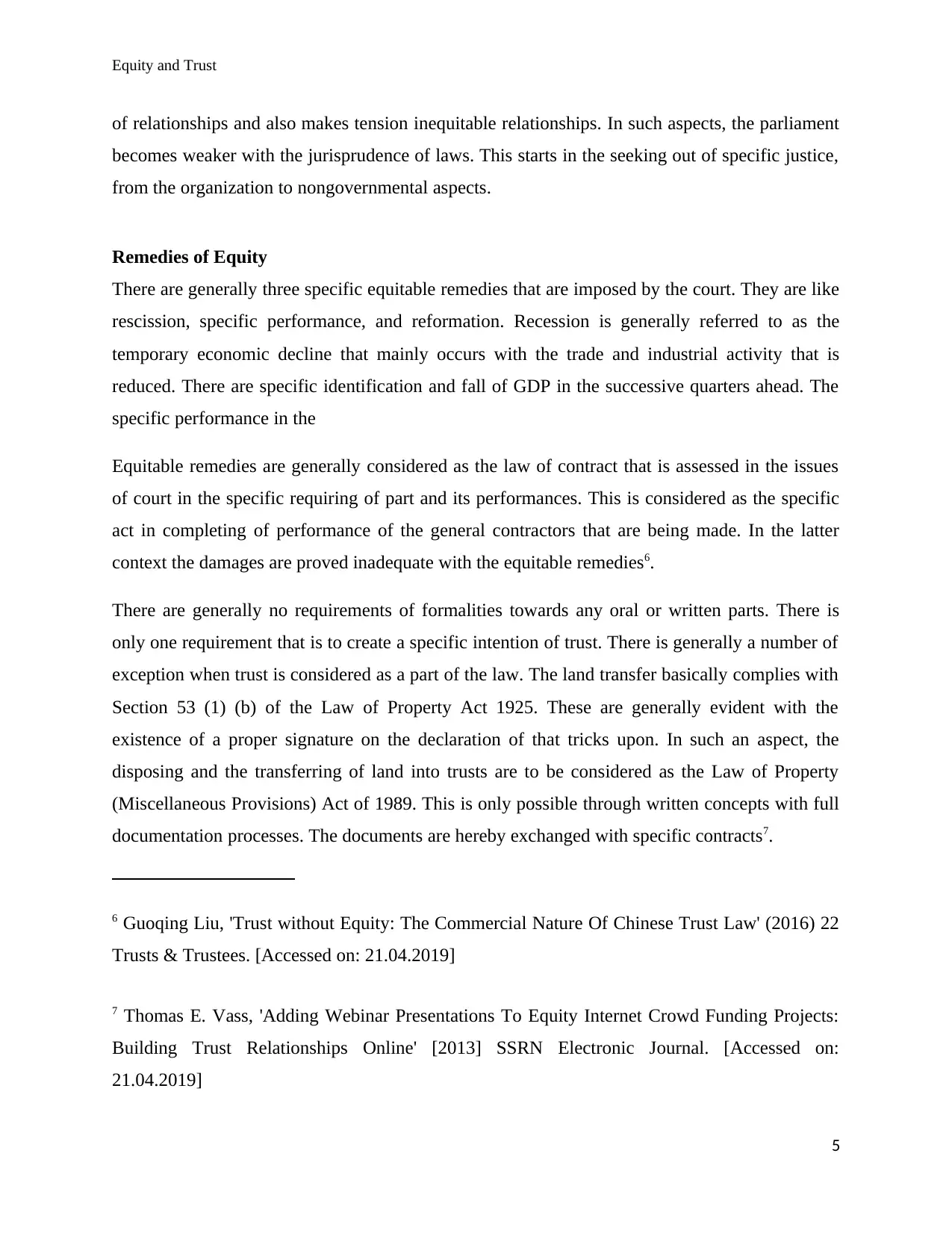
Equity and Trust
of relationships and also makes tension inequitable relationships. In such aspects, the parliament
becomes weaker with the jurisprudence of laws. This starts in the seeking out of specific justice,
from the organization to nongovernmental aspects.
Remedies of Equity
There are generally three specific equitable remedies that are imposed by the court. They are like
rescission, specific performance, and reformation. Recession is generally referred to as the
temporary economic decline that mainly occurs with the trade and industrial activity that is
reduced. There are specific identification and fall of GDP in the successive quarters ahead. The
specific performance in the
Equitable remedies are generally considered as the law of contract that is assessed in the issues
of court in the specific requiring of part and its performances. This is considered as the specific
act in completing of performance of the general contractors that are being made. In the latter
context the damages are proved inadequate with the equitable remedies6.
There are generally no requirements of formalities towards any oral or written parts. There is
only one requirement that is to create a specific intention of trust. There is generally a number of
exception when trust is considered as a part of the law. The land transfer basically complies with
Section 53 (1) (b) of the Law of Property Act 1925. These are generally evident with the
existence of a proper signature on the declaration of that tricks upon. In such an aspect, the
disposing and the transferring of land into trusts are to be considered as the Law of Property
(Miscellaneous Provisions) Act of 1989. This is only possible through written concepts with full
documentation processes. The documents are hereby exchanged with specific contracts7.
6 Guoqing Liu, 'Trust without Equity: The Commercial Nature Of Chinese Trust Law' (2016) 22
Trusts & Trustees. [Accessed on: 21.04.2019]
7 Thomas E. Vass, 'Adding Webinar Presentations To Equity Internet Crowd Funding Projects:
Building Trust Relationships Online' [2013] SSRN Electronic Journal. [Accessed on:
21.04.2019]
5
of relationships and also makes tension inequitable relationships. In such aspects, the parliament
becomes weaker with the jurisprudence of laws. This starts in the seeking out of specific justice,
from the organization to nongovernmental aspects.
Remedies of Equity
There are generally three specific equitable remedies that are imposed by the court. They are like
rescission, specific performance, and reformation. Recession is generally referred to as the
temporary economic decline that mainly occurs with the trade and industrial activity that is
reduced. There are specific identification and fall of GDP in the successive quarters ahead. The
specific performance in the
Equitable remedies are generally considered as the law of contract that is assessed in the issues
of court in the specific requiring of part and its performances. This is considered as the specific
act in completing of performance of the general contractors that are being made. In the latter
context the damages are proved inadequate with the equitable remedies6.
There are generally no requirements of formalities towards any oral or written parts. There is
only one requirement that is to create a specific intention of trust. There is generally a number of
exception when trust is considered as a part of the law. The land transfer basically complies with
Section 53 (1) (b) of the Law of Property Act 1925. These are generally evident with the
existence of a proper signature on the declaration of that tricks upon. In such an aspect, the
disposing and the transferring of land into trusts are to be considered as the Law of Property
(Miscellaneous Provisions) Act of 1989. This is only possible through written concepts with full
documentation processes. The documents are hereby exchanged with specific contracts7.
6 Guoqing Liu, 'Trust without Equity: The Commercial Nature Of Chinese Trust Law' (2016) 22
Trusts & Trustees. [Accessed on: 21.04.2019]
7 Thomas E. Vass, 'Adding Webinar Presentations To Equity Internet Crowd Funding Projects:
Building Trust Relationships Online' [2013] SSRN Electronic Journal. [Accessed on:
21.04.2019]
5

Equity and Trust
Formalities
In respect to the rule of formalities, equitable interest falls as an exception. In such an aspect, the
equitable trust is disposed of which are specifically written and also are signed in the concept of
equitable interest. In such an instance, it can be said that nominating of a person to receive
certain kinds of benefits of funds after the death of the demise of the actual pension holders are
not at all valid. It is also the same for the case of nomination of achieving benefits in the
insurance policies. Therefore there are certain kinds of formalities that are to be maintained in
order to follow the legal procedures in a proper way. There are basic formalities that are related
to wills. The validation of wills should comply with the Wills Act 1837. There are signatures on
testator that are generally intended in the giving of the effect with the presence of at least two
witnesses8.
Difference between Equitable interest and Legal interest
There are several differences between the equitable interest and Legal interest. Both represent a
specific sense of ownership on the assets. It also includes legal interest and equitable interest.
The legal interest generally comprises when a person has specific ownership over an asset. He or
she can legally claim over the assets as it is mandated to individual ownership. On the other
hand, equitable interest is vested when a person enjoys the asset without owning it legally. In
such aspect it can be said if a person wants to buy a property then he has to make its full
payment. But until and unless he makes the payment, the person enjoys the asset without owning
it legally. But once the full payment is done, and then only the asset is being legally transferred
to that person. This is because the valuation of any item changes with time. But in the term of
signing a contract, there was a specific deal between the contractors and the person that she will
buy the land with a xyz price. Therefore fluctuation is an important part in such aspect9.
8 Equity Through CSR: The Mediating Role Of Trust' (2015) 33 International Journal of Bank
Marketing. [Accessed on: 22.04.2019]
9 Heeju Chae and Eunju Ko, 'Customer Social Participation In The Social Networking Services
And Its Impact Upon The Customer Equity Of Global Fashion Brands' (2016) 69 Journal of
Business Research. [Accessed on: 22.04.2019]
6
Formalities
In respect to the rule of formalities, equitable interest falls as an exception. In such an aspect, the
equitable trust is disposed of which are specifically written and also are signed in the concept of
equitable interest. In such an instance, it can be said that nominating of a person to receive
certain kinds of benefits of funds after the death of the demise of the actual pension holders are
not at all valid. It is also the same for the case of nomination of achieving benefits in the
insurance policies. Therefore there are certain kinds of formalities that are to be maintained in
order to follow the legal procedures in a proper way. There are basic formalities that are related
to wills. The validation of wills should comply with the Wills Act 1837. There are signatures on
testator that are generally intended in the giving of the effect with the presence of at least two
witnesses8.
Difference between Equitable interest and Legal interest
There are several differences between the equitable interest and Legal interest. Both represent a
specific sense of ownership on the assets. It also includes legal interest and equitable interest.
The legal interest generally comprises when a person has specific ownership over an asset. He or
she can legally claim over the assets as it is mandated to individual ownership. On the other
hand, equitable interest is vested when a person enjoys the asset without owning it legally. In
such aspect it can be said if a person wants to buy a property then he has to make its full
payment. But until and unless he makes the payment, the person enjoys the asset without owning
it legally. But once the full payment is done, and then only the asset is being legally transferred
to that person. This is because the valuation of any item changes with time. But in the term of
signing a contract, there was a specific deal between the contractors and the person that she will
buy the land with a xyz price. Therefore fluctuation is an important part in such aspect9.
8 Equity Through CSR: The Mediating Role Of Trust' (2015) 33 International Journal of Bank
Marketing. [Accessed on: 22.04.2019]
9 Heeju Chae and Eunju Ko, 'Customer Social Participation In The Social Networking Services
And Its Impact Upon The Customer Equity Of Global Fashion Brands' (2016) 69 Journal of
Business Research. [Accessed on: 22.04.2019]
6
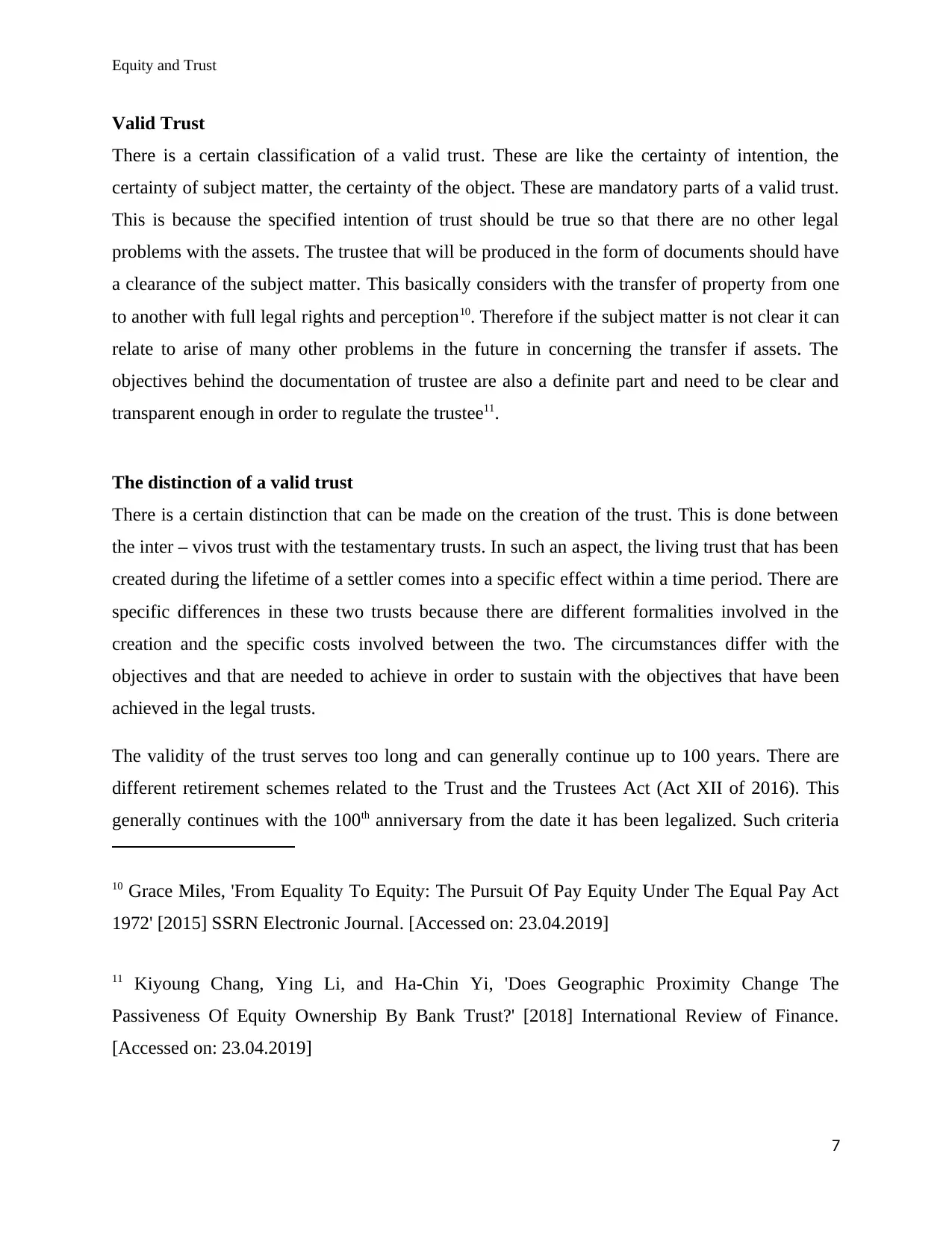
Equity and Trust
Valid Trust
There is a certain classification of a valid trust. These are like the certainty of intention, the
certainty of subject matter, the certainty of the object. These are mandatory parts of a valid trust.
This is because the specified intention of trust should be true so that there are no other legal
problems with the assets. The trustee that will be produced in the form of documents should have
a clearance of the subject matter. This basically considers with the transfer of property from one
to another with full legal rights and perception10. Therefore if the subject matter is not clear it can
relate to arise of many other problems in the future in concerning the transfer if assets. The
objectives behind the documentation of trustee are also a definite part and need to be clear and
transparent enough in order to regulate the trustee11.
The distinction of a valid trust
There is a certain distinction that can be made on the creation of the trust. This is done between
the inter – vivos trust with the testamentary trusts. In such an aspect, the living trust that has been
created during the lifetime of a settler comes into a specific effect within a time period. There are
specific differences in these two trusts because there are different formalities involved in the
creation and the specific costs involved between the two. The circumstances differ with the
objectives and that are needed to achieve in order to sustain with the objectives that have been
achieved in the legal trusts.
The validity of the trust serves too long and can generally continue up to 100 years. There are
different retirement schemes related to the Trust and the Trustees Act (Act XII of 2016). This
generally continues with the 100th anniversary from the date it has been legalized. Such criteria
10 Grace Miles, 'From Equality To Equity: The Pursuit Of Pay Equity Under The Equal Pay Act
1972' [2015] SSRN Electronic Journal. [Accessed on: 23.04.2019]
11 Kiyoung Chang, Ying Li, and Ha-Chin Yi, 'Does Geographic Proximity Change The
Passiveness Of Equity Ownership By Bank Trust?' [2018] International Review of Finance.
[Accessed on: 23.04.2019]
7
Valid Trust
There is a certain classification of a valid trust. These are like the certainty of intention, the
certainty of subject matter, the certainty of the object. These are mandatory parts of a valid trust.
This is because the specified intention of trust should be true so that there are no other legal
problems with the assets. The trustee that will be produced in the form of documents should have
a clearance of the subject matter. This basically considers with the transfer of property from one
to another with full legal rights and perception10. Therefore if the subject matter is not clear it can
relate to arise of many other problems in the future in concerning the transfer if assets. The
objectives behind the documentation of trustee are also a definite part and need to be clear and
transparent enough in order to regulate the trustee11.
The distinction of a valid trust
There is a certain distinction that can be made on the creation of the trust. This is done between
the inter – vivos trust with the testamentary trusts. In such an aspect, the living trust that has been
created during the lifetime of a settler comes into a specific effect within a time period. There are
specific differences in these two trusts because there are different formalities involved in the
creation and the specific costs involved between the two. The circumstances differ with the
objectives and that are needed to achieve in order to sustain with the objectives that have been
achieved in the legal trusts.
The validity of the trust serves too long and can generally continue up to 100 years. There are
different retirement schemes related to the Trust and the Trustees Act (Act XII of 2016). This
generally continues with the 100th anniversary from the date it has been legalized. Such criteria
10 Grace Miles, 'From Equality To Equity: The Pursuit Of Pay Equity Under The Equal Pay Act
1972' [2015] SSRN Electronic Journal. [Accessed on: 23.04.2019]
11 Kiyoung Chang, Ying Li, and Ha-Chin Yi, 'Does Geographic Proximity Change The
Passiveness Of Equity Ownership By Bank Trust?' [2018] International Review of Finance.
[Accessed on: 23.04.2019]
7
Paraphrase This Document
Need a fresh take? Get an instant paraphrase of this document with our AI Paraphraser
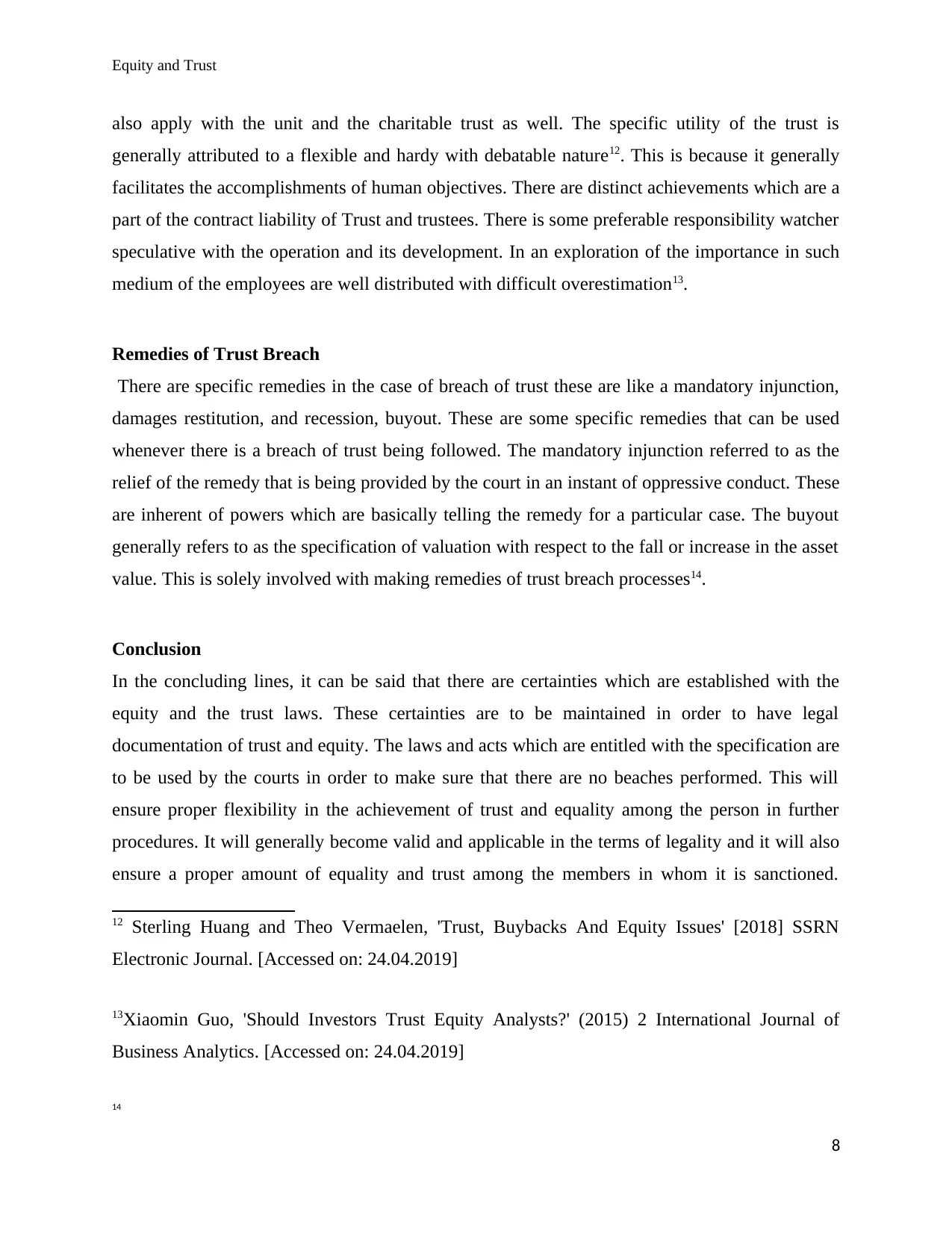
Equity and Trust
also apply with the unit and the charitable trust as well. The specific utility of the trust is
generally attributed to a flexible and hardy with debatable nature12. This is because it generally
facilitates the accomplishments of human objectives. There are distinct achievements which are a
part of the contract liability of Trust and trustees. There is some preferable responsibility watcher
speculative with the operation and its development. In an exploration of the importance in such
medium of the employees are well distributed with difficult overestimation13.
Remedies of Trust Breach
There are specific remedies in the case of breach of trust these are like a mandatory injunction,
damages restitution, and recession, buyout. These are some specific remedies that can be used
whenever there is a breach of trust being followed. The mandatory injunction referred to as the
relief of the remedy that is being provided by the court in an instant of oppressive conduct. These
are inherent of powers which are basically telling the remedy for a particular case. The buyout
generally refers to as the specification of valuation with respect to the fall or increase in the asset
value. This is solely involved with making remedies of trust breach processes14.
Conclusion
In the concluding lines, it can be said that there are certainties which are established with the
equity and the trust laws. These certainties are to be maintained in order to have legal
documentation of trust and equity. The laws and acts which are entitled with the specification are
to be used by the courts in order to make sure that there are no beaches performed. This will
ensure proper flexibility in the achievement of trust and equality among the person in further
procedures. It will generally become valid and applicable in the terms of legality and it will also
ensure a proper amount of equality and trust among the members in whom it is sanctioned.
12 Sterling Huang and Theo Vermaelen, 'Trust, Buybacks And Equity Issues' [2018] SSRN
Electronic Journal. [Accessed on: 24.04.2019]
13Xiaomin Guo, 'Should Investors Trust Equity Analysts?' (2015) 2 International Journal of
Business Analytics. [Accessed on: 24.04.2019]
14
8
also apply with the unit and the charitable trust as well. The specific utility of the trust is
generally attributed to a flexible and hardy with debatable nature12. This is because it generally
facilitates the accomplishments of human objectives. There are distinct achievements which are a
part of the contract liability of Trust and trustees. There is some preferable responsibility watcher
speculative with the operation and its development. In an exploration of the importance in such
medium of the employees are well distributed with difficult overestimation13.
Remedies of Trust Breach
There are specific remedies in the case of breach of trust these are like a mandatory injunction,
damages restitution, and recession, buyout. These are some specific remedies that can be used
whenever there is a breach of trust being followed. The mandatory injunction referred to as the
relief of the remedy that is being provided by the court in an instant of oppressive conduct. These
are inherent of powers which are basically telling the remedy for a particular case. The buyout
generally refers to as the specification of valuation with respect to the fall or increase in the asset
value. This is solely involved with making remedies of trust breach processes14.
Conclusion
In the concluding lines, it can be said that there are certainties which are established with the
equity and the trust laws. These certainties are to be maintained in order to have legal
documentation of trust and equity. The laws and acts which are entitled with the specification are
to be used by the courts in order to make sure that there are no beaches performed. This will
ensure proper flexibility in the achievement of trust and equality among the person in further
procedures. It will generally become valid and applicable in the terms of legality and it will also
ensure a proper amount of equality and trust among the members in whom it is sanctioned.
12 Sterling Huang and Theo Vermaelen, 'Trust, Buybacks And Equity Issues' [2018] SSRN
Electronic Journal. [Accessed on: 24.04.2019]
13Xiaomin Guo, 'Should Investors Trust Equity Analysts?' (2015) 2 International Journal of
Business Analytics. [Accessed on: 24.04.2019]
14
8

Equity and Trust
Therefore there is a need for proper maintenance of legal procedures in order to make any
specification regarding documents of equity and trust.
9
Therefore there is a need for proper maintenance of legal procedures in order to make any
specification regarding documents of equity and trust.
9
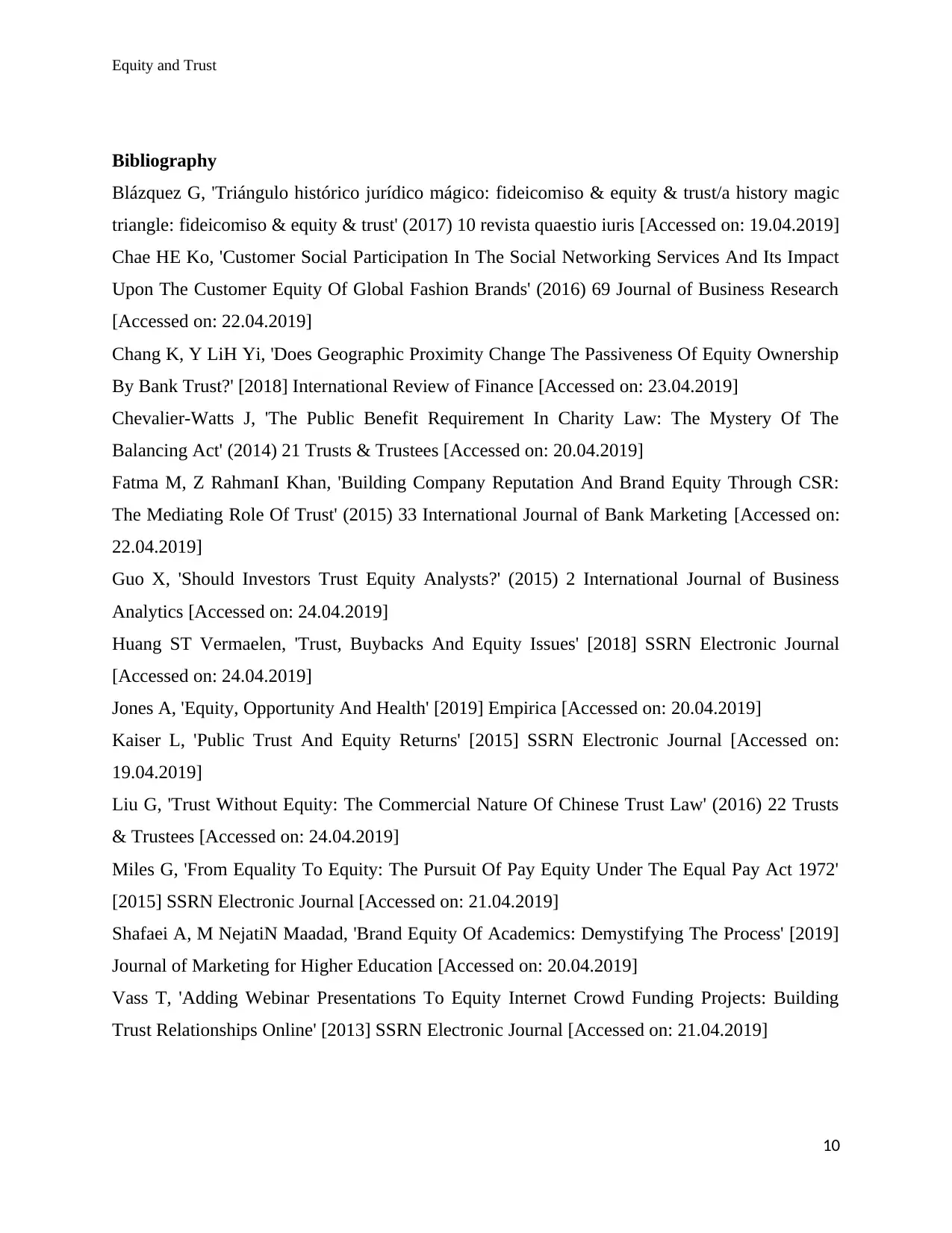
Equity and Trust
Bibliography
Blázquez G, 'Triángulo histórico jurídico mágico: fideicomiso & equity & trust/a history magic
triangle: fideicomiso & equity & trust' (2017) 10 revista quaestio iuris [Accessed on: 19.04.2019]
Chae HE Ko, 'Customer Social Participation In The Social Networking Services And Its Impact
Upon The Customer Equity Of Global Fashion Brands' (2016) 69 Journal of Business Research
[Accessed on: 22.04.2019]
Chang K, Y LiH Yi, 'Does Geographic Proximity Change The Passiveness Of Equity Ownership
By Bank Trust?' [2018] International Review of Finance [Accessed on: 23.04.2019]
Chevalier-Watts J, 'The Public Benefit Requirement In Charity Law: The Mystery Of The
Balancing Act' (2014) 21 Trusts & Trustees [Accessed on: 20.04.2019]
Fatma M, Z RahmanI Khan, 'Building Company Reputation And Brand Equity Through CSR:
The Mediating Role Of Trust' (2015) 33 International Journal of Bank Marketing [Accessed on:
22.04.2019]
Guo X, 'Should Investors Trust Equity Analysts?' (2015) 2 International Journal of Business
Analytics [Accessed on: 24.04.2019]
Huang ST Vermaelen, 'Trust, Buybacks And Equity Issues' [2018] SSRN Electronic Journal
[Accessed on: 24.04.2019]
Jones A, 'Equity, Opportunity And Health' [2019] Empirica [Accessed on: 20.04.2019]
Kaiser L, 'Public Trust And Equity Returns' [2015] SSRN Electronic Journal [Accessed on:
19.04.2019]
Liu G, 'Trust Without Equity: The Commercial Nature Of Chinese Trust Law' (2016) 22 Trusts
& Trustees [Accessed on: 24.04.2019]
Miles G, 'From Equality To Equity: The Pursuit Of Pay Equity Under The Equal Pay Act 1972'
[2015] SSRN Electronic Journal [Accessed on: 21.04.2019]
Shafaei A, M NejatiN Maadad, 'Brand Equity Of Academics: Demystifying The Process' [2019]
Journal of Marketing for Higher Education [Accessed on: 20.04.2019]
Vass T, 'Adding Webinar Presentations To Equity Internet Crowd Funding Projects: Building
Trust Relationships Online' [2013] SSRN Electronic Journal [Accessed on: 21.04.2019]
10
Bibliography
Blázquez G, 'Triángulo histórico jurídico mágico: fideicomiso & equity & trust/a history magic
triangle: fideicomiso & equity & trust' (2017) 10 revista quaestio iuris [Accessed on: 19.04.2019]
Chae HE Ko, 'Customer Social Participation In The Social Networking Services And Its Impact
Upon The Customer Equity Of Global Fashion Brands' (2016) 69 Journal of Business Research
[Accessed on: 22.04.2019]
Chang K, Y LiH Yi, 'Does Geographic Proximity Change The Passiveness Of Equity Ownership
By Bank Trust?' [2018] International Review of Finance [Accessed on: 23.04.2019]
Chevalier-Watts J, 'The Public Benefit Requirement In Charity Law: The Mystery Of The
Balancing Act' (2014) 21 Trusts & Trustees [Accessed on: 20.04.2019]
Fatma M, Z RahmanI Khan, 'Building Company Reputation And Brand Equity Through CSR:
The Mediating Role Of Trust' (2015) 33 International Journal of Bank Marketing [Accessed on:
22.04.2019]
Guo X, 'Should Investors Trust Equity Analysts?' (2015) 2 International Journal of Business
Analytics [Accessed on: 24.04.2019]
Huang ST Vermaelen, 'Trust, Buybacks And Equity Issues' [2018] SSRN Electronic Journal
[Accessed on: 24.04.2019]
Jones A, 'Equity, Opportunity And Health' [2019] Empirica [Accessed on: 20.04.2019]
Kaiser L, 'Public Trust And Equity Returns' [2015] SSRN Electronic Journal [Accessed on:
19.04.2019]
Liu G, 'Trust Without Equity: The Commercial Nature Of Chinese Trust Law' (2016) 22 Trusts
& Trustees [Accessed on: 24.04.2019]
Miles G, 'From Equality To Equity: The Pursuit Of Pay Equity Under The Equal Pay Act 1972'
[2015] SSRN Electronic Journal [Accessed on: 21.04.2019]
Shafaei A, M NejatiN Maadad, 'Brand Equity Of Academics: Demystifying The Process' [2019]
Journal of Marketing for Higher Education [Accessed on: 20.04.2019]
Vass T, 'Adding Webinar Presentations To Equity Internet Crowd Funding Projects: Building
Trust Relationships Online' [2013] SSRN Electronic Journal [Accessed on: 21.04.2019]
10
1 out of 10
Related Documents
Your All-in-One AI-Powered Toolkit for Academic Success.
+13062052269
info@desklib.com
Available 24*7 on WhatsApp / Email
![[object Object]](/_next/static/media/star-bottom.7253800d.svg)
Unlock your academic potential
© 2024 | Zucol Services PVT LTD | All rights reserved.




